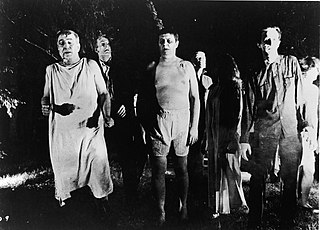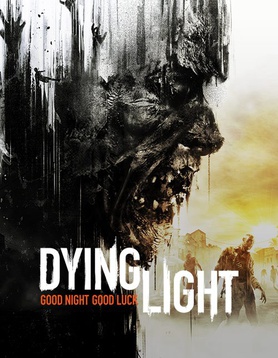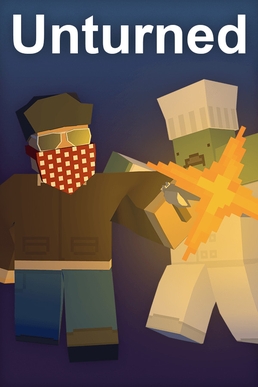
Muldraugh is a home rule-class city in Meade and Hardin counties in the U.S. state of Kentucky. It lies on U.S. Route 31W north of Elizabethtown. The city limits are completely encompassed by the Fort Knox army base. The population was 1,040 as of the 2020 census. The city is part of the Elizabethtown–Fort Knox Metropolitan Area.
Blockland is a sandbox game in which players build and play using Lego-like building blocks in singleplayer and multiplayer. It was created by American developer Eric "Badspot" Hartman, using the Torque Game Engine, and was originally released as freeware on November 15, 2004. The game is not endorsed by, or affiliated with, the Lego brand. However, at one point, Lego was in talks with Hartman about purchasing the game. Blockland was spotlighted on The Screen Savers on February 11, 2005, drastically increasing the user base overnight. It has also been featured on Shack News. Blockland was officially released on February 24, 2007. On December 16, 2013, Blockland was released on Steam after spending nearly a year on Steam Greenlight.

The Corrupted Blood incident took place between September 13 and October 8, 2005, in World of Warcraft, a massively multiplayer online role-playing game (MMORPG) developed by Blizzard Entertainment. When participating in a boss battle at the end of a raid, player characters would become infected with a debuff that was transmitted between characters in close proximity. While developers intended to keep the effects of the debuff in the boss's game region, a programming oversight soon led to an in-game pandemic throughout the fictional world of Azeroth.

Mod DB is a website that focuses on general video game modding. It was founded in 2002 by Scott "INtense!" Reismanis. As of September 2015, the Mod DB site has received over 604 million views, has more than 12,500 modifications registered, and has hosted more than 108 million downloads. A spin-off website, Indie DB, was launched in 2010 and focuses on indie games and news.

Zombie apocalypse is a subgenre of apocalyptic and post-apocalyptic fiction in which society collapses due to overwhelming swarms of zombies. Typically only a few individuals or small bands of survivors are left living. In some versions, the reason the dead rise and attack humans is unknown, in others, a parasite or infection is the cause, framing events much like a plague. Some stories have every corpse rise, regardless of the cause of death, whereas others require exposure to the infection.

World of the Living Dead(WoTLD) : Resurrection was a real-time zombie survival strategy browser game developed using OpenStreetMap to provide the underlying game world, with in-depth gameplay features to make a browser-based massively multiplayer online role-playing game accessible on desktop, tablet and mobile devices.

Desura was a digital distribution platform for the Microsoft Windows, Linux and OS X platforms. The service distributed games and related media online, with a primary focus on small independent game developers rather than larger companies. Desura contained automated game updates, community features, and developer resources. The client allowed users to create and distribute game mods as well.

Terraria is a 2011 action-adventure sandbox game developed by Re-Logic. The game was first released for Windows and has since been ported to other PC and console platforms. The game features exploration, crafting, building, painting, and combat with a variety of creatures in a procedurally generated 2D world. Terraria received generally positive reviews and by 2022 had sold 44 million copies, making it one of the best-selling video games.
Survival mode, or horde mode, is a game mode in a video game in which the player must continue playing for as long as possible without dying in an uninterrupted session while the game presents them with increasingly difficult waves of challenges. A variant of the mode requires that the player last for a certain finite amount of time or number of waves, after which victory is achieved and the mode ends. The mode is particularly common among tower defense games, where the player must improve the defenses of a specific location in order to repel enemy forces for as long as possible. Survival mode has been compared to the gameplay of classic arcade games, where players face off against increasingly stronger waves of enemies. This mode was intended to give the game a definite and sometimes sudden ending, so that other players could then play the arcade game as well.

CastleMiner is a 2011 video game developed by American indie studio DigitalDNA Games and released on Xbox Live Indie Games on July 27, 2011. It is a block-building sandbox game that uses Xbox Live Avatars as the player characters. Less than four months after its initial release, a sequel to the game called CastleMiner Z was released on November 9, 2011. A third game, CastleMiner Warfare, was released for Windows PCs in 2013.

State of Decay is a 2013 action-adventure survival video game developed by Undead Labs and published by Microsoft Studios. The game combines elements of shooters, stealth, role-playing and strategy games and the game challenges players to survive by exploring, scavenging, and fighting the undead. It places emphasis on how the player's leaderships skills fare against an onslaught of problems, such as diminishing survival resources, group trust and morale, zombie extermination, base defenses, and people's lives.

Keen Software House is an independent video game developing company based in Prague, Czech Republic. The company was founded by Marek Rosa in 2010.

Dying Light is a 2015 survival horror video game developed by Techland and published by Warner Bros. Interactive Entertainment. The game's story follows an undercover agent named Kyle Crane who is sent to infiltrate a quarantine zone in a fictional Middle Eastern city called Harran. It features an enemy-infested, open-world city with a dynamic day–night cycle, in which zombies are slow and clumsy during daytime but become extremely aggressive at night. The gameplay is focused on weapons-based combat and parkour, allowing players to choose fight or flight when presented with dangers. The game also features an asymmetrical multiplayer mode, and a four-player co-operative multiplayer mode.
Dead Rising is a series of action-adventure games created by Keiji Inafune. It was originally developed by Capcom until Capcom Vancouver took over developing the franchise. As of September 30, 2023, the game series has sold 16 million copies worldwide and is currently Capcom's sixth most successful intellectual property.

7 Days to Die is a survival horror video game set in an open world developed by The Fun Pimps. It was released through Early Access on Steam for Microsoft Windows and Mac OS X on December 13, 2013, and for Linux on November 22, 2014. Versions for the PlayStation 4 and Xbox One were released in 2016 through Telltale Publishing, but are no longer being developed. In late 2022, The Fun Pimps announced that the game will be re-released on consoles targeting Xbox Series X/S and PlayStation 5.
Space Engineers is a voxel-based sandbox game, developed and published by Czech independent developer Keen Software House. In 2013, the initial developmental release of the game joined the Steam early access program. During the following years of active development, Space Engineers sold over one million units. In total as of 2019 the game has sold over 3.5 million copies In May 2015, for approximately a year and a half, the game's source code was officially available and maintained by KSH to assist the modding community. On December 15, 2016, the game entered Beta and was later officially released on February 28, 2019.

Call of Duty: Advanced Warfare is a 2014 first-person shooter video game published by Activision. The eleventh major installment in the Call of Duty series, the game was developed by Sledgehammer Games for PlayStation 4, Windows and Xbox One, while High Moon Studios developed the versions released on PlayStation 3 and Xbox 360, and Raven Software developed the game's multiplayer and the Exo-Zombies mode.

Unturned is a free-to-play survival game by Smartly Dressed Games, a studio consisting solely of Canadian game designer Nelson Sexton. It was released for Windows, macOS, and Linux in July 2014. Unturned allows players to create custom maps using an in-game editor. Cosmetics and mods can also be created using the game's Unity engine, which allows them to publish creations on the Steam Workshop. A retail version of the game was released for the PlayStation 4 and Xbox One by 505 Games in November 2020.

Minetest is a free and open-source game creation system with focus on voxel graphics. It is written primarily in C++ and makes use of the Irrlicht Engine. Minetest provides an API for users to write their own games and mods written in Lua. It is cross-platform, being available for Microsoft Windows, macOS, Linux, some BSD descendants, some GNU variants and Android.
















